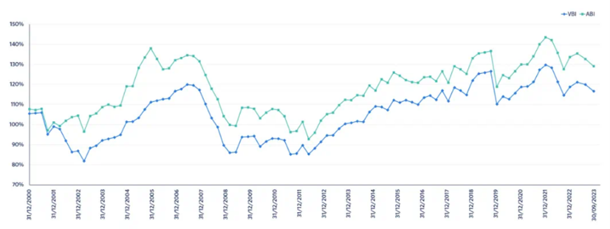Pre-retirement
In Australia, saving for retirement is mandatory. In 1992 the Superannuation Guarantee (SG) was introduced with a 3% employer contribution rate. By 2002, this was 9% and is currently 11.5%. Most are members of a Defined Contribution (DC) “super” fund where the default investment vehicle aims to maximise investment returns over the individual’s working life.
The introduction of SG has resulted in a large, predominantly DC retirement savings system. At 30 June 2023, around 90% of the A$3.5 trillion of retirement savings were in DC funds.
Until recently, the focus of the superannuation industry has been on the pre-retirement phase. This has resulted in a great system pre-retirement which is likely to produce adequate savings at the point of retirement. However, when it comes to converting this pot into an adequate retirement income, Australia’s super system, well, is not so super.
Australia’s post-retirement challenges
Currently, retirees in Australia typically use an account-based pension - a drawdown facility with legislated minimum withdrawals that increase with age. Some will be able to navigate retirement successfully, by picking suitable withdrawal rates, potentially by receiving good quality financial advice.
Unsurprisingly, many retirees withdraw only at the legislated minimum, leading to inadequate income in retirement and excess savings at death. Others withdraw at a higher rate, risking running out of money before death and ultimately relying on state provision.
Therefore, a DC only system is unlikely to meet Australia’s objective of superannuation “to preserve savings and deliver income for a dignified retirement, alongside government support, in an equitable and sustainable way.” for all individuals, despite the great pre-retirement phase.
The superannuation industry is aware of the shortcomings in the retirement phase and recently has turned its attention to delivering adequate retirement income. Lifetime retirement income products have emerged that either pool or insure longevity risk, transferring this away from individuals, while remaining invested in growth assets.
We believe that pooling member risk via Collective Defined Contribution (CDC) schemes could benefit savers in the UK. In the interest of learning from overseas experience, we’ll look at two adopters of CDC schemes in Australia.
Australian Retirement Trust’s Lifetime Pension
With 2.3 million members and over $260 billion assets under management the Australian Retirement Trust (ART) is one of the largest superannuation funds in Australia. At retirement, members of ART have the option to purchase a lifetime pension. At age 65 a member can convert DC retirement savings into an annual income at a rate of $100,000 for $6,716 (or $6,107 if spouse protection is selected).
The members assets are then pooled and invested largely in growth assets. The goal is to generate returns of CPI + 4%, allowing the lifetime pension to increase over time. Annual actuarial calculations adjust all members income for the next year. If the annual investment return is higher than 5%, income for the next year will increase, and if it's lower than 5%, income will decrease. There is an adjustment for the mortality experience too.
Since the products inception in 2020, the annual adjustment in income has ranged from -6.89% to +7.53%. So, in the absence of a guarantee, there is some volatility in income amounts year on year.
UniSuper Defined Benefit(?) Division
UniSuper is another large super fund in Australia, with over 647,000 members and $139bn of assets under management. UniSuper offers a similar product to ART called Lifetime Income, launched in 2015. If a member purchases a Lifetime Income, then it’s provided from assets made up of Lifetime Income members and the Defined Benefit Division (DBD).
The DBD was established in 1983 for staff of Australian Universities and remains open to new members within this profession. Benefits in the DBD are provided as a salary linked lump sum with the option of converting this into a CPI linked lifetime pension. At 30 June 2023, the DBD had assets of over $30bn.
Crucially, in the DBD the employer and member contributions are fixed. Employers contribute 14% and the members contribute 7%. Therefore, if the funding level of the DBD falls below 100%, the trustees cannot ask the employers to pay deficit recovery contributions. Instead, the Trustee has a mechanism in place called the monitoring period.
The monitoring period then lasts for four years, and if the funding level hasn’t improved the trustee must consider reducing benefits. Meaning that UniSuper’s DBD, is really a whole of life CDC scheme.
Monitoring periods occurred in 2008, 2011, 2012 and 2013. However, benefits were only adjusted for the 2008 monitoring period and only benefits accrued from 2015 were slightly changed. For 2011, 2012 and 2013 the funding level improved and no reduction to benefits was required (see chart below).

Under the current UK regulation for CDC schemes, deficits are not allowed. Deficits must be removed annually through immediate or future decreases of benefits. However, by taking a longer-term view and not adjusting benefits every year, members of UniSuper are able to receive a stable CPI linked income via a CDC. A stable income is obviously important for managing budgets and spending power, but it’s also likely to be easier for members to understand and get behind.
Are buffers bad?
In the UK, a ‘no buffers’ approach to CDC is favoured. The Government decided that providing benefit increases to current members when a surplus arises is a more transparent approach.
At 30 June 2023, UniSuper’s DBD had a surplus of over 30%, which is retained as a buffer. From 2006 and 2012, the funding level dropped from nearly 140% to just over 90%. Despite the turmoil in investment markets the DBD continued to provide inflation linked income to members, with no reduction to accrued benefits. Under the UK’s approach, material benefit reductions would have occurred over this period, and benefit enhancements in the years prior.
Learnings
1. Australia’s Super system highlights that even if done very well, a DC only private retirement savings system, is unlikely to be optimal for all.
2. Decumulation CDC can provide a lifetime retirement income. However, ART’s design means there will be some volatility in annual income year on year.
By allowing for short-term deficits and surpluses, CDC schemes can provide more stable, predictable income, making retirement outcomes more equitable and sustainable for members.
If you have any questions, or would like to discuss further, please get in touch.
This blog is based upon our understanding of events as at the date of publication. It is a general summary of topical matters and should not be regarded as financial advice. It should not be considered a substitute for professional advice on specific circumstances and objectives. Where this blog refers to legal matters please note that Hymans Robertson LLP is not qualified to provide legal opinion and therefore you may wish to obtain independent legal advice to consider any relevant law and/or regulation. Please read our Terms of Use - Hymans Robertson.
References




